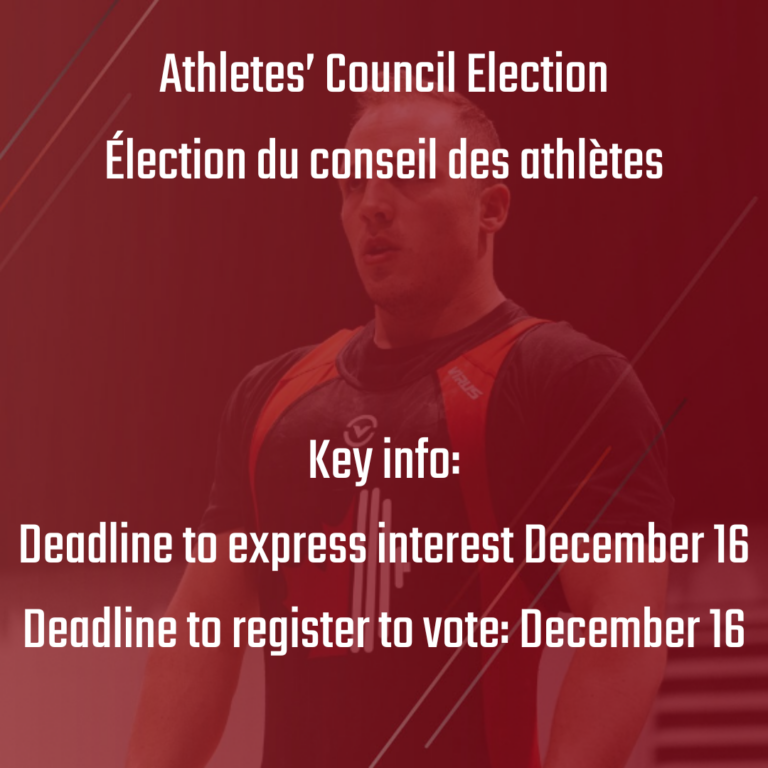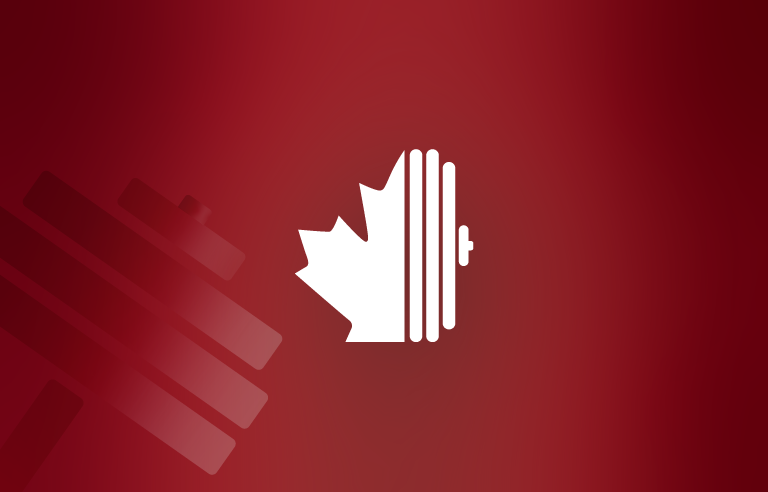History of Canadian Weightlifting
Weightlifting Canada Haltérophile was first under the governance of the A.A.U. (Amateur Athletic Union of Canada) from 1947 to 1959. It was officially founded in 1960 under the acronym CWFHC and counts more than 3000 active members today.
Weightlifting has been an Olympic discipline since the first modern games in 1896. It is also featured on the program of the Commonwealth Games and Pan American Games.
Weightlifting movements, as we know them today, were first introduced at the 1928 Olympic Games. At these Games and all subsequent Games until 1972, there were three Olympic lifts, namely the press, the snatch and the clean and jerk. Beginning in 1972, the press was withdrawn to make the snatch and the clean and jerk the two movements of Olympic weightlifting.
For many years, weightlifting as a competitive sport was reserved for men. It was in 1987 that the first women’s world weightlifting championship was held.
The first Olympic Games to feature women’s weightlifting were in Sydney 2000. Maryse Turcotte, Canada’s only female representative at this event, is the first Canadian woman to compete in the Olympic Games in weightlifting. She finished 4th in the 58 kg category.
Weight classes in weightlifting have changed many times throughout history. Today, men and women are respectively divided into 10 categories:
Women: 45, 49, 55, 59, 64, 71, 76, 81, 87, 87+ kg
Men: 55, 61, 67, 73, 81, 89, 96, 102, 109, 109+ kg
Canada had and still has many brilliant athletes. In 1952, G. Gratton won a silver medal at the Helsinski Olympics. In 1953, Doug Hepburn won the world championship in the heavyweight category in Stockholm. In 1984, Jacques Demers won silver in the 75 kg category at the Olympic Games in Los Angeles. Finally, weightlifter Christine Girard, who placed 4th at the Beijing Olympics in 2008 and was a bronze medalist at the London Olympics in 2012, was awarded in 2016 the bronze medal for Beijing 2008 and gold for London 2012 following the late charges of doping offenses by her competitors. These results made Christine the first Olympic champion as well as the first double Olympic medalist in Canadian weightlifting history.
Until the 2021, the best Canadian female and male performances in history were attributed to Christine Girard, with a total of 238 kg in the 63 kg in 2011, and to Boady Santavy, with a total of 384 kg among the 96 kg in 2019.
In 2021 Maude Charron won a gold medal at the 2020 Tokyo Olympics with the exact same total as Christine Girard, however she had a personal best competition in April 2021 at the rescheduled 2020 Pan American Championships with a 240 total (107/133). Boady Santavy finished 4th at the Tokyo Olympics where he was 1st after the Snatch portion of the competition and missed out on a medal by a mere 1kg. Boady also had a personal best competition at the rescheduled 2020 Pan American Championships achieving a 389 total (181/208).
MARCELLA LECLERC
“You don’t ask for a place, you take it! ”
Marcella Leclerc is a pioneer of women’s weightlifting in Canada. She enthusiastically agreed to open up to WCH to talk about her athletic journey as the first woman in Canada to practice competitive weightlifting. We thank her greatly for her generosity. It should be noted that she was known as Marcelle Leclerc during her weightlifting career, but for the past 30 years or so she has used the first name Marcella. Here’s her story briefly …
It was in 1980 that Marcella Leclerc started weightlifting. At only 14 years of age, she was part of her high school’s women’s rugby team. Rugby being an atypical sport for women of her age at the time, her team had to compete against college teams to be able to participate in tournaments. In order for her and her teammates to be more competitive with these women who were 6 years older and 50 lbs heavier, the physical education teacher in charge tried to get them to train in weightlifting. 18 of the 20 girls on the team declined the offer, claiming that they were not strong enough and that weightlifting was for men. Marcella is naturally curious and loves to try new things. She’s athletic at heart. In addition to rugby, at the time she practiced dance, athletics at the provincial level (3000 m), and sometimes even played lacrosse with her brother. She agreed to start training with just one of the other players.
The training room was the size of a shed. There were 2 platforms and 2 or 3 bars (20 kg bars, now considered to be men’s bars). She performed a few clean and jerks and quickly learned the technique. It was so natural that the teacher asked her if she had done it before. She immediately develops a passion for the strength sport. About 2 years later, she decided to focus solely on weightlifting. She still had a great love for dancing, but her teacher often mentioned that she no longer had the body to be graceful in ballet because her muscles were starting to develop. She joins the weightlifting club ‘’Les Spartiates de Valleyfield’’. Canadian team athlete Alain Roy trains there, and he helps Marcella with training programs and a bit of technical correction.
In September 1984, at just 18, Marcella has a plan. She wants to leave Valleyfield, find a study program elsewhere, in a city where she could train more adequately in weightlifting. She chooses the radiation therapy program at College Ahuntsic in Montreal, so that she can train at the Claude-Robillard Center, where the men’s national weightlifting team trains. She can now benefit from the guidance of coach Pierre Roy. Her technique improved quickly. When she first started at this training center, she didn’t feel unanimously welcomed with open arms in this largely male environment. At the time, she assessed the opinion of other club members as follows: 50% in favor of women’s weightlifting, 10% indifferent and 40% who opposed her participation in the sport. But Marcella is a woman of character, and she didn’t let herself be discouraged or intimidated. In addition, she can count on some men from the national team who encourage her, such as Jacques Demers, Denis Garon, Guy Greavette and Langis Côté. The latter is still a good friend to this day.
On March 8, 1985 (International Women’s Day), Marcella participated in the Quebec Games in La Sarre. As the only girl in competitive weightlifting, she competed against boys in the same group. She finishes 7th out of 15 participants.
In 1986, coach Augustin Brassard takes her under his wing. Having done the same training programs, very heavy in volume and intensity, as men throughout her career up to this point, she sees a big improvement when Mr. Brassard adapts her programs to her personal recovery capacity.
In March 1986, the first international women’s weightlifting meet was organized in Hungary. The President of the Quebec Weightlifting Federation talks about this opportunity to Marcella, but Weightlifting Canada Haltérophilie had already planned to put its budget in certain competitions for the Men’s National Team and declined the offer, explaining that it can’t afford to send a women’s team to this competition. Determined to participate, Marcella calls the International Weightlifting Federation. A few days later, the WCH releases funds and announces that it would send 2 women to this event: Marcella Leclerc and Manon Ratelle (Club Gros-Bill, Quebec). This competition would be the highlight Marcella’s career, who had never traveled by plane before. With a snatch of 57.5 kg and a clean and jerk of 72.5 kg (Canadian record) in the 56 kg and under category, she finished 1st in the Sinclair rankings. Marcella is not strong by nature, but she stands out greatly for her technique compared to lifters from other countries. Following this competition, she makes the front page of the prestigious World Weightlifting magazine. Women’s weightlifting takes a new turn in Canada. It is exposed like never before in the media such as La Presse and Radio-Canada (CBC). Marcella is called “world champion” everywhere. All this publicity helps to brighten the image of weightlifting in the country, tarnished a few years earlier by doping scandals.
Marcella participated in 3 World Championships during her career: Daytona Beach 1987, Jakarta 1988 and Budapest 1990. 3 months before her participation in the latter, she found herself without a coach. Unfortunately, her performance did not live up to her expectations, but she has fond memories of this prestigious competition. Women weightlifters had improved tremendously technically and in strength, compared to the international invitation of 1987. The event organization was also of much better quality.
When asked how she feels looking at the evolution of women’s weightlifting in Canada from her time to today, one word comes to her mind: PRIDE! For her, weightlifting is an extremely complete sport, which requires extraordinary athletic and mental capacities. It is also a sport which, according to her, is still too underestimated and unrecognized. When she sees these athletic women, with beautiful techniques, who do not deny their femininity in this strength sport, she finds it magnificent.
The message she wants to leave is for girls and women who are weightlifters or who want to start: “It’s always been in my temper. For me, there is no activity that is more for men or for women. The female weightlifters haven’t stolen anything from anyone. The place we occupy today is rightfully ours. You should never blame yourself for advocating for fairness. Many doors have been opened over the past 40 years, and although there is still work to be done, there is no door that will remain closed forever. The important thing is not to take anything for granted. We must continue to demand. You don’t ask for a place, you take it. I never saw my fellow female weightlifters as rivals or enemies. We must avoid working against each other. We must join our efforts to advance the sport. ”
Marcella continues to follow weightlifting on social media, especially this summer for the weightlifters who represented their country at the Tokyo Olympics. She intends to return to weightlifting by getting involved as an official over the next few years.


